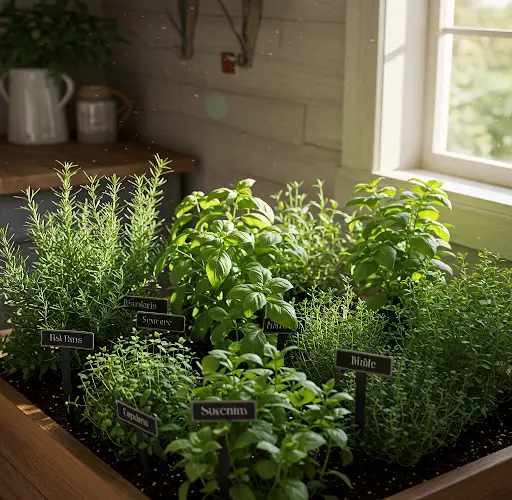Grow Herbs at Home: A Fresh, Flavorful, and Easy Gardening Project
Imagine stepping outside your kitchen or onto your balcony and snipping a few fresh basil leaves for your pasta, or mint for your tea. Growing herbs at home is not only convenient—it’s rewarding, space-efficient, and can save money in the long run. Whether you have a garden, a balcony, or just a sunny windowsill, herbs are among the easiest and most useful plants to grow.
This guide will show you how to grow a variety of herbs at home with simple tools and a few key tips, even if you’re short on space or new to gardening.
Why Grow Herbs at Home?
Herbs are some of the most practical and low-maintenance plants you can grow. They’re fast-growing, don’t need much room, and many are pest-resistant. Homegrown herbs are also fresher and more flavorful than store-bought versions, which often wilt quickly and lack aroma.
Some additional benefits include:
-
Healthier cooking: Fresh herbs can transform simple meals into flavorful dishes without relying on salt or artificial flavorings.
-
Natural remedies: Herbs like mint, basil, and oregano have medicinal properties and can be used for home remedies or teas.
-
Aromatic beauty: Herbs are not just useful—they’re attractive and aromatic, adding beauty and fragrance to your living space.
Best Herbs to Grow at Home
Start with popular, easy-to-grow varieties like:
-
Basil – Great for Italian dishes, grows well in warm, sunny spots.
-
Mint – Refreshing and fast-spreading; perfect for teas and desserts.
-
Rosemary – Woody, fragrant, and ideal for roasting meats and vegetables.
-
Oregano – A hardy herb perfect for Mediterranean and Mexican recipes.
-
Parsley – Rich in vitamins and adds freshness to many meals.
-
Thyme – A compact, drought-tolerant herb that’s great for stews and marinades.
-
Coriander (Cilantro) – Grows quickly and is widely used in Asian and Latin cuisine.
-
Chives – Mild onion flavor, grows well in containers and even indoors.
Choosing Where to Grow Your Herbs
You can grow herbs:
-
In pots or containers on balconies, patios, or windowsills.
-
In raised beds or garden plots if you have yard space.
-
Vertically, using wall planters or hanging baskets for small spaces.
Choose a location that gets at least 4–6 hours of sunlight per day. Herbs like basil, rosemary, and oregano love the sun, while mint and parsley can tolerate partial shade.
Step-by-Step Guide to Growing Herbs
1. Prepare the Containers or Soil Bed
Use pots with drainage holes to prevent waterlogging. Fill them with a good-quality potting mix—preferably one enriched with compost or organic material. For garden beds, loosen the soil and mix in compost or aged manure for nutrients.
2. Plant the Herbs
You can start herbs from seeds or buy young seedlings from a nursery.
-
Seeds: Sow directly into the soil about ¼ inch deep. Keep the soil moist until germination.
-
Seedlings: Gently transplant them into the pot or bed. Space them out to allow airflow and root development.
3. Water Properly
Water your herbs when the top inch of soil feels dry. Overwatering is a common mistake. Herbs prefer slightly dry soil over soggy roots, especially Mediterranean varieties like rosemary and thyme.
4. Add Mulch (Optional)
Mulching with straw, dried leaves, or compost can help retain moisture, suppress weeds, and keep soil temperatures steady.
5. Prune and Harvest Regularly
Regular harvesting encourages herbs to grow bushier and produce more leaves. Always harvest with clean scissors, cutting just above a leaf node. Avoid cutting more than one-third of the plant at once.
Care and Maintenance Tips
-
Fertilizing: Feed herbs every 3–4 weeks with a diluted organic liquid fertilizer or compost tea. Avoid overfeeding—too much nitrogen can reduce flavor.
-
Pest control: Use natural deterrents like neem oil or garlic spray if aphids or whiteflies appear.
-
Re-potting: Fast-growing herbs like mint may need to be re-potted or divided every few months.
-
Rotation: For garden beds, rotate herb varieties each season to maintain soil health.
Indoor Herb Growing
If you’re short on outdoor space, herbs can thrive indoors near a sunny window or under grow lights. Use smaller pots, keep them away from cold drafts, and water sparingly. Windowsills and kitchen counters are great spots, especially for quick-use herbs like basil and parsley.
Final Thoughts
Growing herbs at home is a simple yet enriching hobby. With minimal effort, you can enjoy a constant supply of fresh ingredients for your kitchen, improve your home’s air quality, and even explore herbal remedies for health and wellness. Whether you have a sprawling backyard or just a windowsill, there’s always room for herbs.
So grab a pot, a handful of seeds, and start your herb garden today. Fresh flavor is only a few steps away—right from your home.



